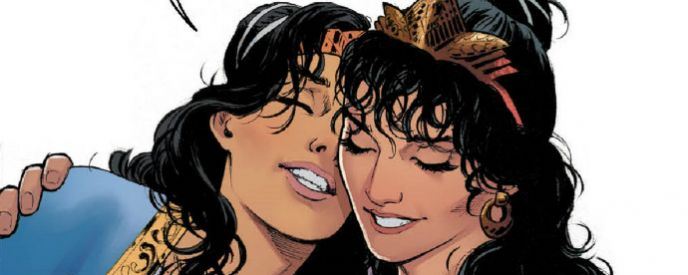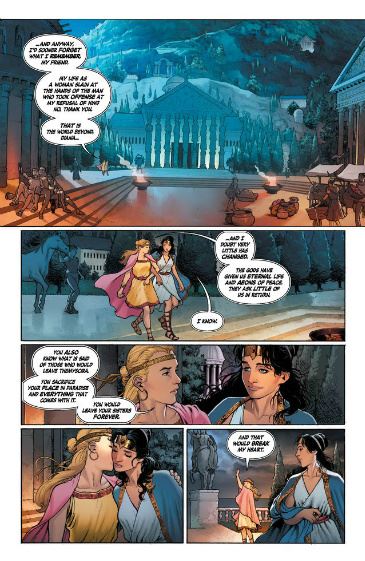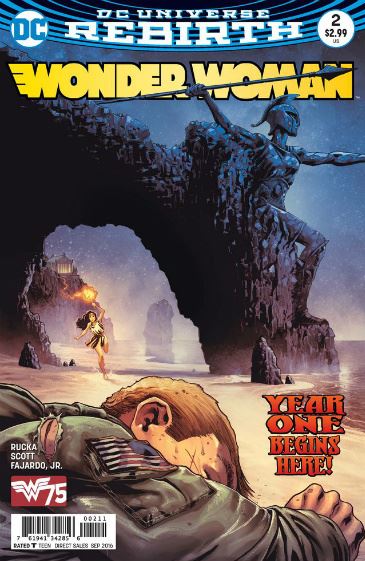Comics /
Comic Reviews /
DC Comics
Wonder Woman #2: A Review

By Zak Edwards
July 14, 2016 - 14:59
With Wonder Woman running biweekly, Greg Rucka is alternating storylines: one set in the present and one origin story that starts right here in issue #2. Creating a "Wonder Woman: Year One" in 2016 feels a bit like the Amazing Spider-Man film series: a little too soon and a little too similar. In just the past five years alone, we've had three Wonder Woman origin stories just in the comics alone. They're starting to pile up and, despite the stellar team, this does feel like we're treading over some very familiar ground. If anything, this storyline feels like a waste, even if it's an amazing and beautiful read and in line with Rucka's very meta Rebirth Special.
I’m not sure what’s driving this need to show a fresh-faced Diana, all bright-eyed, bushy-tailed, and curious as to what men even look like. I can certainly guess, though. I have four theories:
1. Everyone likes the bildungsroman, the “coming of age” story where experience replaces innocence, so why not?
2. To destabilize the obviously flawed utopia that is Themyscira (known to many, subtly, as Paradise Island).
3. It’s just a logical thing to do when reboots are a fairly regular occurrence.
4. They wanted to do something totally different and new and ended up not doing that.
Just like anything that happens on the regular, these origins are starting to blend together. Or perhaps more accurately, Rucka’s "Wonder Woman: Year One" is a pastiche of the very recent and it’s not even trying to cover it up, especially when it comes to this year’s earlier Wonder Woman origin story,
Earth One (comics love the number 1, certainly more than 52 these days).
Wonder Woman: Earth One, not to be confused with "Wonder Woman: Year One," is a standalone graphic novel is about many things, but it’s largely about the move from second wave feminism into the intersectional feminism of today. It’s an
awkward attempt, to be sure, but it does a bunch of things really, really well and looks amazing doing it. Like Rucka’s story here, Morrison’s script is also about Diana on Themyscira, longing to leave, and having a dude crash land on the island as a catalyst to her departure. But Rucka’s origin story skirts around much of what Morrison made explicit.
The best example of this skirting happens early in the issue, as Diana and her “friend” Kasia discuss the current state of Diana’s discontent. After a fairly standard “inexperience vs. cynicism” exchange, artist Nicola Scott dedicates a sole, silent panel to Kasia kissing Diana on the cheek, followed up by Kasia claiming Diana will “break [her] heart.”
 |
| The frustrating moment. Art by Nicola Scott. |
The scene is probably skipped by for most, which would seem to be part of its purpose, but it’s also frustrating. For Morrison, sexuality on Themyscira was inevitable and Diana openly took female lovers. She fucked and fought and it was glorious. Here, Diana’s innocence and near-virginal purity throws her back in the closet, and she and the audience are left to wait for the aforementioned crash-landing dudes.
Perhaps it’s this virginal wish that sustains male writers’ fascination with a younger Diana. The desire to see a powerful woman as a novice shield-maiden instead of the godlike general seen last issue. At least with Morrison, virginal purity was replaced with simple inexperience. For
Rebirth, she longingly looks to the horizon and, unbeknownst to her, waits for a man.
My musings on Diana’s dating life aside, the issue is strong, establishing Themyscira, a younger Diana, and a mythology in just a few beautiful pages. The issue brings together a healthy blend of humour, despair, strange mythical plot twists, and pure joy. Even the asides with Steve Trevor’s own origin are full of life and beautiful relationships. The book holds a lot of positivity inside its pages, which is always a welcome relief from the faux-cynicism that comics continually try to replicate, and this joy is where Rucka pushes Diana into something beautiful, albeit with a ton of help from the extraordinary art team.
Nicola Scott and colourist Romulo Fajardo have made the entire issue a place where you want to live, not simply visit. Scott’s paneling is loose and spacious, which make every page inviting and interesting while giving added weight to her gorgeous splash pages. The characters are full of life and, in most cases, look like they stepped out from the hodge podge of Greek mythology from which they are taken. This applies to both the young and expressive Diana and the “really good at holding a beer and looking longingly at others” Steve Trevor, who’s own origin story is told alongside Diana’s.
tl;dr review: I’m still at a loss as to why we like to push Wonder Woman back into her less powerful origins, but this book makes a strong case for a refresher course in what makes her tick. Even if the issue only skirts around the things
Earth One made explicit, the book is a joy to read. If Azzarello made me interested in Wonder Woman, Rucka’s turning me into a fan.
On a side note, Frank Cho is
apparently welching on his variant cover deal. Citing Greg Rucka as the reason, Cho is apparently leaving the book. I personally think this is an excellent decision and, if it went down the way Cho says, I applaud Rucka for not letting Cho compromise this much healthier version of Diana. The next issue’s variant, in its original, was a panty shot and, well, not really what these stories are going for.
Last Updated: January 17, 2025 - 08:20


